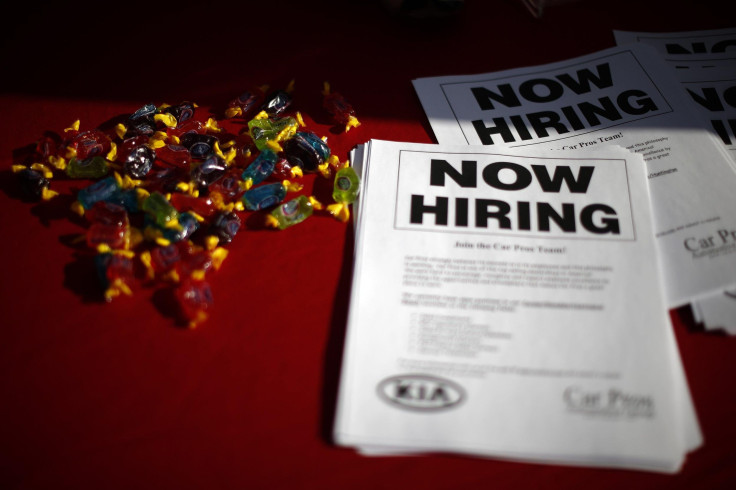US Economy Adds 280,000 Jobs In May, Unemployment Rises To 5.5%

U.S. employment rose by 280,000 jobs last month and the unemployment rate rose to 5.5 percent, the Labor Department said Friday. The report was forecast to show employers adding 225,000 jobs in May and the unemployment rate was expected to remain at 5.4 percent, according to analysts polled by Thomson Reuters.
The unemployment rate ticked higher, but economists note it's for a good reason: More people are coming back into the U.S. labor force, says Tara Sinclair, chief economist at Indeed.com.
Even so, the encouraging numbers mask several weak points in the U.S. job market, including persistent stagnation in wage and productivity growth. As the job market continues to expand, employers are facing a new dilemma: labor shortages. Employers are experiencing shortages of skilled labor, such as in transportation and construction, the Federal Reserve warned in its Beige Book this week, which highlights the current condition of the U.S. economy in each of the Fed's 12 districts.
An ongoing and widespread shortage of truck drivers was noted in the New York City, Cleveland and Kansas City Districts.
“Employers are not offering enough incentives to attract job seekers to those positions,” said Sinclair. Businesses offering jobs now need to consider that they are competing with employers from a range of sectors who might be offering higher wages, better benefits and more appealing job characteristics, Sinclair said.
The tightening competition for workers still hasn't improved the job market's tepid wage growth. The U.S. hasn’t completely climbed out of the hole left by the Great Recession, says Thea Lee, trade economist and deputy chief of staff at the AFL-CIO. “We’re still in some ways playing catchup,” Lee said. “We just have not seen the kind of wage growth to make up for the income loss that happened during the recession. You want to see families at least replace the incomes they lost during the recession and we really haven’t seen that.”
Economists are also troubled by the puzzling decline in productivity. The most important factor the Fed uses to determine U.S. living standards is productivity growth, or increases in how much can be produced in an hour of work. Sustained increases in productivity are necessary to support rising incomes over time.
The growth rate of output per hour worked in the business sector has averaged about 1.25 percent per year since the recession began in late 2007, down from gains averaging 2.75 percent over the preceding decade, Federal Reserve Chair Janet Yellen said recently.
The number of Americans who have been out of work for 27 weeks or longer was essentially unchanged last month, at 2.5 million, constituting 28.6 percent of the unemployed. The average hourly earnings for private-sector workers rose by 8 cents to $24.96. For most workers, however, real wages have fallen or remained flat for more than three decades.
Meanwhile, many Americans who work part-time jobs want to work full time, and nearly two-thirds who are able to work have dropped out of the labor force, the highest proportion opting out of the workforce since the 1970s. The labor-force participation rate was little changed at 62.9 percent, according to the report released Friday.
The participation rate still hovers near a 30-year low because improvements in the labor market are being offset by structural headwinds coming from demographics: baby boomers are retiring and young professionals are going back to school.
Most economists don’t expect to see the participation rate pick up significantly anytime soon. “The strongest negative effects on the participation rate from young people going back into education are probably behind us, but the aging factor is still very much there,” said Jeremy Lawson, Chief Economist of Standard Life Investments.
Economists continue to see the strongest gains in the services sector, including hospitality and leisure, which added 57,000 jobs in May. However, with the precipitous drop in oil prices over the last 12 months, economists expect to continue to see job losses related to energy, such as the oil and mining sector because as investment in those areas declines, employment in those areas will decrease too.
Employment in mining fell for the fifth month in a row, with a decline of 17,000 in May, and has decreased by 68,000 so far this year, after adding 41,000 jobs in 2014.
A strong U.S. dollar is also making it difficult for U.S. manufacturers to compete, meaning sectors exposed to the appreciating dollar will see weak employment growth, such as companies that manufacture exports.
May’s stronger-than-expected report comes after U.S. job growth rebounded in April following a sharp hiring downturn in March. Most economists pushed back expectations the U.S. Federal Reserve would raise interest rates in June as a result of March’s disappointing data, coupled with a sharp slowdown in economic growth in the first quarter.
“There’s no doubt that what the Federal Reserve is waiting for is the return of inflation,” said Mark Hamrick, Washington bureau chief at Bankrate.com. The Fed needs to see some indication that downward pressures on underlying inflation is reversing, with confidence inflation will head back towards the central bank's 2 percent target before the Fed begins lifting interest rates. Most economists expect the central bank will raise rates in September.
The increases, which would be the first in nearly a decade, have not yet come and interest rates remain at historic lows since the financial crisis in 2008.
Jessica Menton is a writer who covers business and the financial markets. News tips? Email me here. Follow me on Twitter @JessicaMenton.
The United States - Overview | StartClass
© Copyright IBTimes 2025. All rights reserved.






















